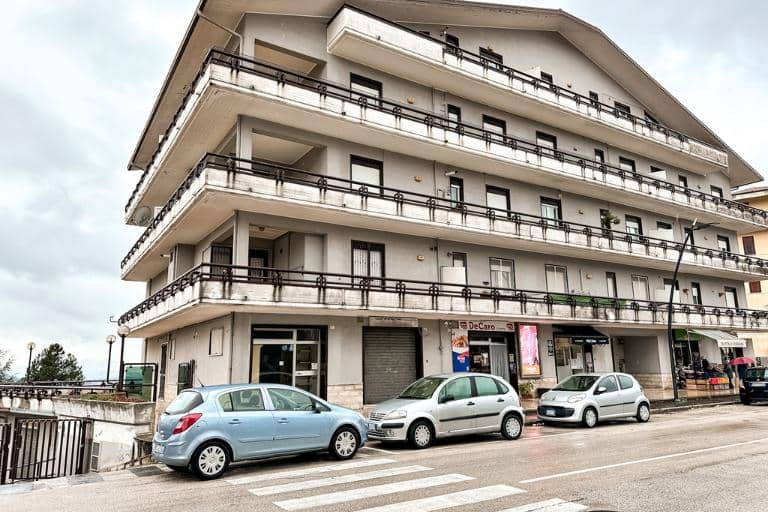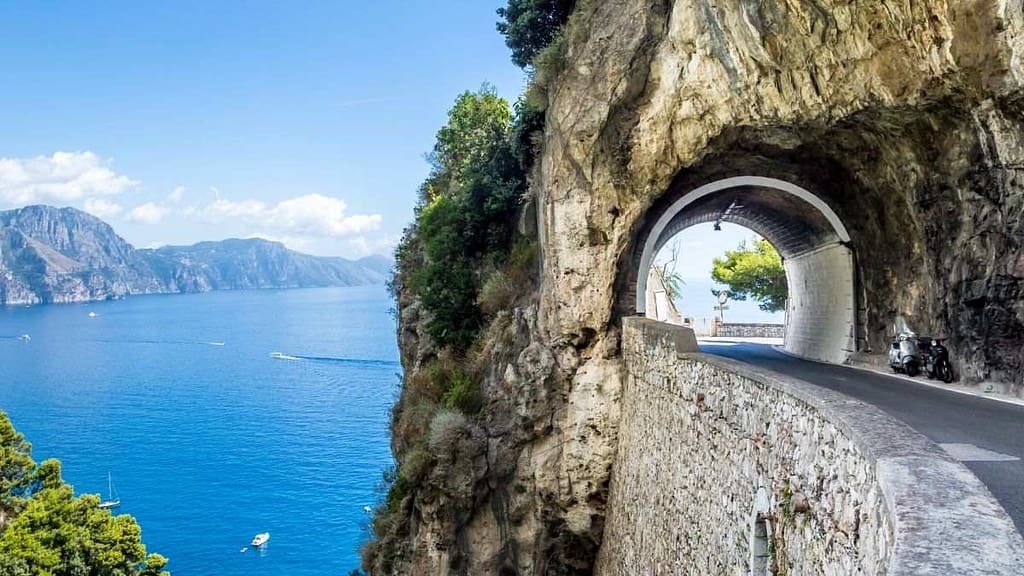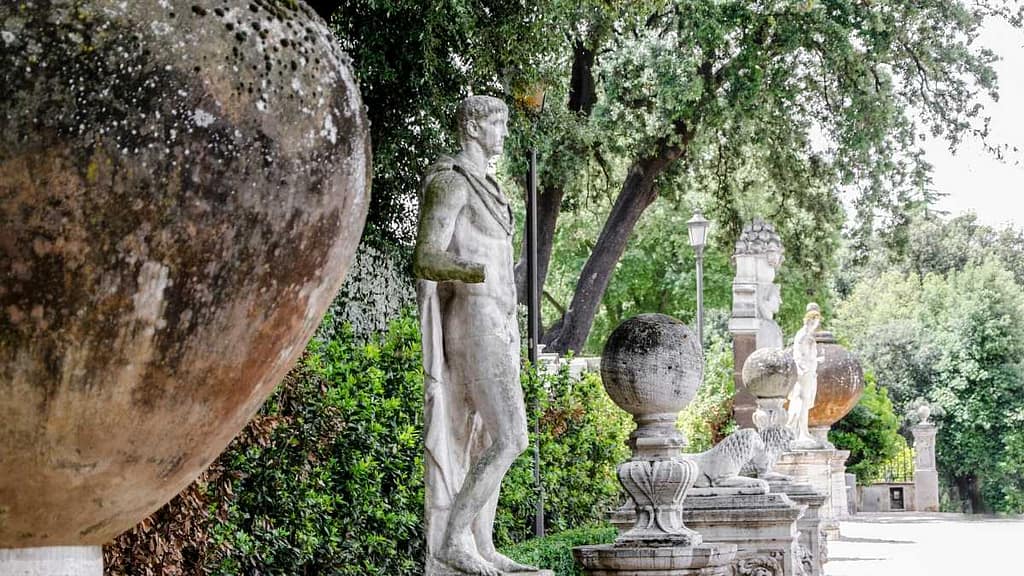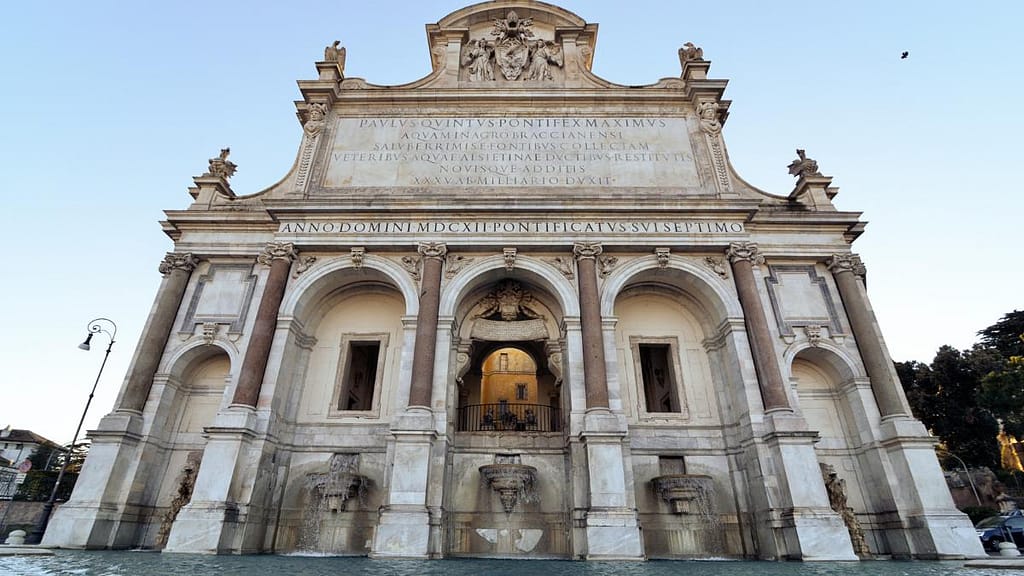Driving in Italy can be many things. From exhilarating and enchanting to scary and frustrating. No matter what, you can always bet that it will be an adventure. After experiencing Italy’s highways, narrow roads and questionable country lanes, we can easily say that seeing the country by car is definitely something everyone coming here should experience at least once.
After living in Italy for a while and having done many road trips, driving here has become a part of our lives. In many ways, it’s not that much different than it is back home in Canada. Sure, the scenery and the roads are different, but the rules of the road remain the same. So, if you’re thinking of renting a car on your next trip to Italy and are unsure about the experience, don’t let the prospect of driving in Italy scare you off. Here is what you need to know about driving in Italy and why it can be a great way to see the country.
This post may contain compensated links. Find out more info in our DISCLAIMER.
- Do you need to drive in Italy?
- Italian driving culture
- Requirements for driving in Italy
- Gas stations in Italy
- Rules of the road
- Toll roads in Italy and how to pay them
- Parking in Italy
- What are Limited Traffic Zones (ZTLs), and how they work
- Tips for renting a car and driving in Italy
- Final thoughts about driving a car in Italy
- FAQ
Do you need to drive in Italy?
Italy has a great network of trains, airports and ports that make travelling within the country easy, fast and safe. However, there is a certain freedom in getting behind the wheel and setting out on an adventure. With a car, you can explore off-the-beaten-path villages, vineyards and scenic landscapes that are often inaccessible by public transportation. Having your own vehicle also means not being tied to train or bus schedules. You can take impromptu detours, linger in newly discovered spots, and discover hidden gems at your own pace.
Driving in Italy can also be a cost-effective option for families or groups of friends travelling together. By splitting rental and fuel costs, you could save significantly compared to individual train or bus tickets. Moreover, you’ll have the convenience of door-to-door transportation, saving you the trouble of carrying heavy luggage between transit points.
Finally, driving is your best way to immerse yourself in the authentic Italian experience. You can drive along winding coastal roads (live out your dream of seeing the Amalfi Coast from a car), through rolling hills (hello Tuscany road trip!) and past stunning architecture – it’s the quintessential Italian road trip. So, on your next trip to Italy, consider renting a car to truly experience the magic and charm of this beautiful country.
Italian driving culture
While unique and energetic, Italy’s driving culture can feel chaotic and intimidating, especially in big cities like Naples or Rome. Italian drivers are known for their assertive driving style, which can come across as aggressive. On the highways, faster drivers will flash their headlights as a signal for slower drivers to move to the right lane. They might even honk at you if they feel you’re not getting out of their way fast enough.

Italians are very proficient at navigating tight spaces and heavy traffic. Many small towns have narrow, winding roads that might be confused for one-way streets but aren’t. In urban areas, scooters or smaller cars will often dart around you seemingly out of nowhere, so always pay attention to what’s around you.

One of the things that can be baffling for visitors is that Italians tend to be somewhat selective about the rules for driving in Italy. For example, you’ll often find cars parked facing each other, regardless of the direction of the traffic. Technically, you’re supposed to park on the right side of the road in the direction of the traffic flow, but you’ll find this rule often ignored. They park on crosswalks, double-park blocking others and even might park perpendicular to the curb, especially if it’s a very small car. While the locals might see the rules as a suggestion, we recommend you stick with them.
Road conditions in Italy
Road conditions in Italy can vary significantly depending on the region and type of road. Highways are generally well-maintained with smooth surfaces, but many smaller roads may have potholes and uneven pavement. You’ll likely find yourself driving through narrow streets lined with parked cars, which can be off-putting at first.


When driving through mountainous regions or rural areas, be prepared for winding roads and steep inclines. Sometimes, there might not be any guardrails or barriers along the road’s edge, so staying aware and driving carefully is crucial. In many small towns like ours, some roads leading in and out of town might not be lit, which can be dangerous since they are narrow and winding.
Requirements for driving in Italy
To drive in Italy, you must be at least 18 and have a valid driver’s license. Drivers from other European countries don’t need any other requirements and can drive with their country’s driver’s licence. If you’re from a non-EU country, you should obtain an International Driving Permit (IDP) and carry it with your domestic license. Remember, an IDP is a translation of your driving license, not a substitute. You have to carry both when driving in Italy. Additionally, you need proof of insurance.
Most car rental companies include basic third-party liability insurance in their rental fee, so check that the car rental company you’re getting your car from does. Your vehicle should also carry a warning triangle and a high-visibility reflective jacket in case of a breakdown. It’s also mandatory to have your headlights on during the day when travelling on motorways and major roads outside cities.

How to obtain an International Driving Permit for Italy
You have to obtain the International Driving Permit (IDP) for Italy in your home country before you travel. In the US, for example, the IDP can be obtained through the American Automobile Association (AAA) or the American Automobile Touring Alliance (AATA). In Canada, you’ll have to go to a Canadian Automobile Association (CAA) office that issues them.
You’ll need two original passport pictures and a valid driver’s license. Complete the application form, which can be found online or at the local office, and pay the fee. Your IDP will be issued immediately over the counter if you apply in person or mailed to you if you apply by post. Remember, the IDP is valid for only one year and must be accompanied by your original driver’s license at all times. It’s worth noting that the IDP is a translation of your driver’s license and not a replacement.
Car seats in Italy
In Italy, safety regulations mandate the use of appropriate car seats for children. For children up to 15 months old, a rearward-facing seat must be used. Once the child surpasses this age, you can switch to a forward-facing seat, though it’s generally recommended to keep using a rear-facing seat for as long as possible.
Children who are 135 cm tall (around 4 feet 5 inches) or under must use a child restraint. A booster seat can be used until the child outgrows this height. Children taller than 135 cm can use an adult seatbelt. Remember, it’s not only important to choose the correct seat but also to install it properly to ensure maximum child safety.
Gas stations in Italy
In Italy, you’ll find a mixture of self-service and full-service gas stations. Self-service stations are often open around the clock, and you’ll need to pay at an automated kiosk. They usually accept both cash and credit cards. Full-service stations, on the other hand, are staffed by attendants who can help you fill up your tank. They’re usually open from Monday to Saturday, with limited hours on Sundays and holidays.
When filling up, keep in mind that ‘Benzina‘ refers to unleaded gasoline, ‘Diesel‘ needs no translation, and ‘GPL’ or ‘Gas’ refers to LPG. If you’re at a self-service station, you’ll need to determine how much fuel you want, pay at the kiosk, and then fill up your vehicle. At a full-service station, an attendant will fill the tank for you, and you can pay them directly, we usually use a credit card to make it easier.
Rules of the road
Similar to other countries, in Italy, you drive on the right-hand side of the road, with overtaking on the left. This is intended for vehicles moving at a slower speed or preparing to exit the road. The far-left lane is commonly used for overtaking slower vehicles or moving at a faster speed.
Italians tend to drive closely to the vehicle in front, so don’t be alarmed if you see less space than you’re accustomed to in your rear-view mirror. Use of the horn is common, often signalling the driver’s intent to proceed or alerting others of their presence rather than expressing irritation.

It’s illegal to use a mobile phone while driving unless you have a hands-free system. Seat belts are mandatory for all passengers, and children under 12 must use a suitable restraint system. The legal driving age in Italy is 18. One can start driving from the age of 16 for mopeds (Category AM) and small-capacity motorcycles (Category A1).
When it comes to drinking and driving in Italy, the legal blood alcohol content (BAC) limit is 0.05%, equivalent to around one small beer. For drivers with less than three years of experience, regardless of their age, the BAC limit is as low as 0.00%. Severe penalties are enforced for drunk driving, including hefty fines, suspension of driving privileges, and in some cases, imprisonment. It’s always advisable to designate a sober driver or utilize public transportation or a taxi if you plan on consuming alcohol.
Roundabouts are commonly used in Italy, and it’s essential to understand the rules of navigating them. Vehicles entering a roundabout must yield to vehicles already inside, including those coming from their left, that have the right of way. It’s common for drivers to use the outer lanes when taking an exit, however, they should always indicate their intended direction with their turn signal.

It’s also important to note that vehicles exiting a roundabout must always yield to pedestrians and cyclists crossing in front of them. Roundabouts can be confusing at first, but with practice, they become natural to navigate. It’s also worth noting that larger roundabouts may have traffic lights installed to help regulate the flow of traffic.
Italy’s road network and speed limits
In Italy, roads are categorized into highways (autostrade), national roads (strade statali), regional roads (strade regional) local roads (strade locale). The most significant road network is, of course, the highway system. These motorways have a toll system in place where drivers must pay a fee based on the distance travelled. However, the cost is often offset by the convenience and efficiency of these well-maintained roads.
The speed limit on highways is usually 130 km/h, but this can vary depending on weather conditions or specific areas with lower speed limits. National roads are free to use and are typically well-maintained, but they may not be as fast and efficient as highways. The speed limit on these roads is usually 90 km/h.
Regional roads are also free to use, but they may be narrower and more winding than national roads. These roads often lead to smaller towns and villages, so it’s essential to drive cautiously and watch out for pedestrians, cyclists, and other vehicles.
Local roads are typically found within city centers and have speed limits of 50 km/h. These roads may be busy with traffic, so it’s important to pay close attention and follow road signs carefully.
Speed traps
In Italy, speed checks and traps are prevalent to enforce the speed limits and ensure road safety. These methods include ‘Autovelox,’ a speed detection system that utilizes a camera and a radar. Autovelox devices are often permanently installed on highways, national roads, and even city roads. They take a photo of your license plate and automatically issue fines to drivers exceeding the speed limit.
Another common speed enforcement method is the ‘Safety Tutor‘ system, exclusive to Italian highways. This unique system measures a vehicle’s average speed over a long distance rather than its instantaneous speed. The system calculates the time taken to travel between two points. If the average speed exceeds the limit, a fine is issued.
Finally, mobile speed traps operated by traffic police, known as ‘Polizia Stradale,’ are also common. These can be temporary setups in areas known for speeding or can be part of random checks. A police officer can use portable radar devices to measure the speed of passing vehicles.
Toll roads in Italy and how to pay them
In Italy, there are various toll roads (autostrade) that you may encounter during your travels. Generally, a ticket pops up once you pull up. Grab it, and the gate will open for you to pass. You pay when you exit. Others might require a one-time payment, which is nominal. It’s good to keep some change on hand for these occasions.

Some tall booths might have an attendant, while others are automated. Once you insert your ticket, the amount you owe will be displayed on the screen. You can pay for tolls with cash, credit or debit cards, prepaid cards specifically for autostrade, and electronic devices called telepass.

When passing toll booths, make sure you select the right lane. Some might be reserved for those holding a telepass, while others are specifically for those paying with a credit/debit card and/or cash. It’s important to know which type of payment the toll booth accepts before approaching it to avoid delays or inconveniences.
If you plan on using toll roads frequently during your trip, ask your car rental agency if you can rent one with the car. Not all rental agencies have that option, nor might think to offer one, but it’s worth asking.
Parking in Italy
Parking can also be a challenge in Italy, especially in major cities where space is limited. Always be aware of parking restrictions and regulations, as parking illegally can result in hefty fines. Blue lines on the curb indicate paid parking zones, while white lines indicate free or unrestricted parking. Yellow lines are for people with disabilities.

If you park in a blue zone, you must purchase a ticket from nearby vending machines and display it on your dashboard. Always check the parking requirements, as some towns have free parking between certain hours or on special days, like Sunday. Some machines might require you to input the car’s licence plate and/or spot marker, which you can find painted on the curb.
If you’re driving in a smaller historic town, it may be easier and more convenient to park outside of the city center and use public transportation or walk. This can save you from navigating through narrow streets and dealing with heavy traffic. There are also many parking garages available in major cities, but be prepared to pay a higher fee for convenience.
What are Limited Traffic Zones (ZTLs), and how they work
Limited Traffic Zones (zona traffico limitato in Italian) are specific areas in many Italian cities where access is restricted or limited to certain types of vehicles. These zones are typically located in historic city centers, pedestrian zones, and other congested areas, where heavy traffic can damage the architectural and cultural heritage.
To enter a ZTL, you must have a permit or authorization to drive within the designated area. These permits are issued to residents, businesses, and certain types of vehicles (such as emergency vehicles and public transportation) with legitimate need to enter the restricted zones.
If you are planning to drive in Italy, pay attention to ZTL signs and avoid entering them unless you have proper authorization. Violating ZTL rules can result in hefty fines, so it’s best to plan your route and parking ahead of time to avoid any issues. We got a steep fine when we accidentally drove through one in Sicily, which wasn’t fun.
Tips for renting a car and driving in Italy
When renting a car in Italy, there are several tips to help you get the most out of your experience:
- Choose the right vehicle: If you’re travelling with a group or a lot of gear, you’ll need a larger car than if you were alone. A smaller car might serve you better in cities and small towns, making it easy to park and navigate through narrow streets.
- Book in advance: Renting a car upon arrival can be more expensive than pre-booking. You also risk the rental company not having the vehicle you need. Try to book your car rental as soon as your travel plans are confirmed.
- Understand the rental agreement: Read the fine print of your rental agreement. Pay attention to the fuel policy, mileage limits, and insurance coverage. Some companies offer unlimited mileage, while others may charge you extra for driving a certain amount.
- Check for damage: Inspect the car for existing damage before you drive away. Take photos of any scratches or dents and ensure the rental company notes them.
- Get GPS or a Local SIM: Navigating Italian roads can be challenging. Consider renting a GPS or buying a local SIM card for your phone to use Google Maps.
- Fuel Up: In Italy, it’s common for car rental companies to charge a refuelling fee if you return the car with less than a full tank. To avoid this, fill up the tank near the drop-off point.
- Drive defensively: Italian drivers are known for their aggressive driving style. Always stay alert, follow the speed limit, and don’t assume other drivers will obey traffic rules.
- Beware of ZTLs: As mentioned above, beware of Limited Traffic Zones (ZTLs). Ensure your route avoids these areas unless you have the appropriate permit.
Consider renting a car with good handling and safety features to ensure a comfortable and safe driving experience in Italy. In case of emergencies or accidents, be sure to have the contact information of your rental car company, insurance provider, and local authorities.
Final thoughts about driving a car in Italy
Seeing Italy by car gives you a lot of independence. It can be a great way to discover new spots that might not have been on your radar. If you’re not comfortable driving in large cities like Rome, Milan or Naples, opt for public transit and walking. Save the driving for getting between towns and cities and exploring smaller, more accessible places. You’ll see Italy in a totally different way and go home with a memorable experience that will last forever.




